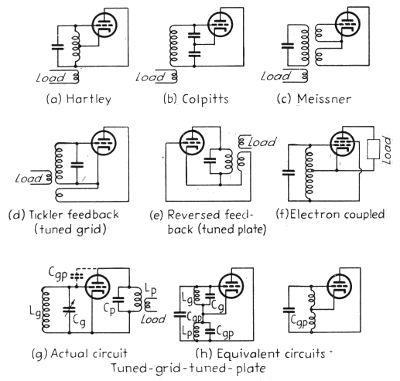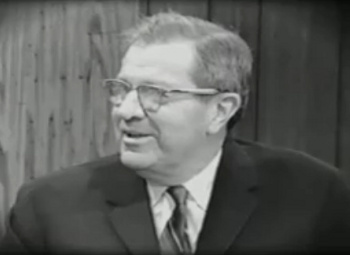Frederick Terman
July 12, 2011
Last Sunday, I added another
dead tree book to my library. This was a special book from an unusual source, a "
hamfest."
Amateur radio operators enjoy meeting to swap stories and equipment, so they have what are called hamfests. The
Sussex County Amateur Radio Club of New Jersey holds its
annual hamfest this time of year at a fairgrounds about forty-five minutes from my house.
I'm not an amateur radio operator myself, but much of my work involved
radio frequency circuits, I have friends who are
hams, and my son is a licensed amateur radio operator. I mix well with this crowd; especially so, because there's an abundance of white hair.
One of the items offered for sale, mixed in with
vacuum tubes and items that only a
radio man of my generation could identify, was a first edition, first impression, of the 1943 book, "Radio Engineers' Handbook," by
Frederick Emmons Terman.[1]
This 1019 page book, published four years before I was born, still contains much useful information. One thing about
science is that once a fundamental principle has been discovered and characterized, it's useful from that point onwards.
Einstein may have improved on
Newton, but we still use
Newtonian mechanics every day.

Figure 1 of chapter six of Frederick Terman's 1943 book, "Radio Engineers' Handbook."
The caption is, "Schematic circuits of common types of power oscillators.
I've always been partial to the Colpitts, although his version is lacking a DC return path for the cathode)
I knew about Terman's father,
Lewis Terman, long before I knew about the son. Lewis Terman was a
psychologist and president of the
American Psychological Association who invented the
Stanford-Binet IQ test. This test got started in a study by the
French psychologist,
Alfred Binet, on French school children with
special needs. The Stanford-Binet name combined his name with that of
Stanford University where the elder Terman taught.
In the US, at least, the emphasis for intelligence testing shifted from those at the low end of the scale to the high end, and every mother wanted a
genius child. As a teenager, I was interested in the
nature vs. nurture debate as to whether genius, or more formally,
general intelligence, was
mostly genetic.
In the 1960s, the problem was cast as what fraction of intelligence was big-
G, the
genetic, or
nature, part of intelligence, and what fraction was little-
g, the
nurture part.
Physicists use
big-G and
little-g in a different context. Recent research has shown that the
heritability of IQ is about 0.75, which is quite significant, but this heritability seems to express itself only in adulthood.
The younger Terman must have been enriched in both nature and nurture, since he's credited as being the "Father of
Silicon Valley." Surprisingly, Terman started with an undergraduate degree in
chemistry from Stanford, but he then continued there for a master's degree in
electrical engineering. He received his doctoral degree (
Sc.D., as it's called there) from
MIT in 1924. His advisor at MIT was
Vannevar Bush, whom I wrote about in a
previous article (Basic Research, October 22, 2010).

Frederick Terman from the YouTube video, "The Father of Silicon Valley - Frederick Terman," by the Santa Clara Valley Historical Association.[2]
(Used with permission).[3])
Terman must have liked Stanford, since he returned there to teach electrical engineering, and he stayed at Stanford for forty years, becoming
dean, then
provost and acting
president.[4] His lasting contribution to the former technical dominance of the US was in establishing the first university-owned
industrial park at Stanford before
World War II.
William Hewlett and
David Packard, who were two of his
graduate students, started
Hewlett-Packard there. Terman was instrumental in getting
William Shockley to start
his semiconductor company in the area in 1956.[4] Although Shockley's venture had middling success, the
startups formed by its former employees helped in the growth of Silicon Valley.
Terman directed the
Radio Research Laboratory at
Harvard University during World War II, one product of which was
chaff. Chaff was a
radar countermeasure that consisted of strips of aluminum that were ejected from aircraft to cause confusing radar reflections. Nowadays, such countermeasures are all electronic and are called
electronic countermeasures (ECM).
After the War, the Stanford Industrial park became home to
Lockheed Corporation,
Varian Associates,
General Electric and
Eastman Kodak, in addition to Hewlett-Packard, forming the technology base for Silicon Valley. Also after the war, Terman expanded science and technology at Stanford to establish a foundation for government funding. Income from this, and through
patent license fees, enabled Stanford to become a first rank university.
Terman was awarded the
IRE Medal of Honor in 1950, and he was a founding member of the
National Academy of Engineering. Frederick Emmons Terman died on December 19, 1982, at age 82.
The following is an interesting
Terman quotation:
"It is better to have one seven-foot jumper on your team than any number of six-foot jumpers."
Since I mentioned IQ testing, I have two personal anecdotes on that topic. When I was in fifth grade, I was given an IQ test. One question that I remember from that test was to choose the type of person most like a
physician. Two of the choices were a
lawyer and a
plumber. The "right" answer was lawyer, since physicians and lawyers are both professionals. The answer I chose was plumber. When you consider all the piping in the human body, such as
arteries,
veins and
intestines, plumbing makes the most sense.
That test also asked for my birth date. I knew the day and month, but I wasn't quite sure about the year. I remembered its being an
odd number, so that narrowed it down to 1947 or 1949. I chose 1949, which made me two years younger than I really was. Since IQ is the ratio of "mental age" to physical age, if I was a normal ten year old, that change would have given me an IQ of 125. They do check these things, don't they?
References:
- Frederick Emmons Terman, Sc.D., "Radio Engineers' Handbook," McGraw-Hill, 1943, 1019 pages.
- Santa Clara Valley Historical Association, "The Father of Silicon Valley - Frederick Terman," YouTube video.
- Santa Clara Valley Historical Association Web Site.
- Frederick Terman, PBS Transistor Web Site.
- Frederick Terman page on Wikipedia.
Permanent Link to this article
Linked Keywords: Dead tree book; Amateur radio operator; hamfest; Sussex County Amateur Radio Club of New Jersey; annual hamfest; radio frequency; circuit; vacuum tube; radio; Frederick Emmons Terman; science; Albert Einstein; Isaac Newton; Newtonian mechanics; Lewis Terman; psychologist; American Psychological Association; Stanford-Binet IQ test; French; Alfred Binet; special education; special needs; Stanford University; genius; nature vs. nurture; general intelligence; heritability of IQ; genetic; physicist; gravitational constant; big-G; gravitational acceleration; little-g; estimates of heritability of IQ; Silicon Valley; chemistry; electrical engineering; Doctor of Science; Sc.D.; Massachusetts Institute of Technology; MIT; Vannevar Bush; basic research; YouTube video; dean; provost; president; industrial park; World War II; William Hewlett; David Packard; graduate student; Hewlett-Packard; William Shockley; Shockley Semiconductor Laboratory; startup; Radio Research Laboratory; Harvard University; chaff; radar; electronic countermeasures (ECM); Lockheed Corporation; Varian Associates; General Electric; Eastman Kodak; patent; IRE Medal of Honor; National Academy of Engineering; Terman quotation; physician; lawyer; plumber; artery; vein; ntestine; odd number; Santa Clara Valley Historical Association.